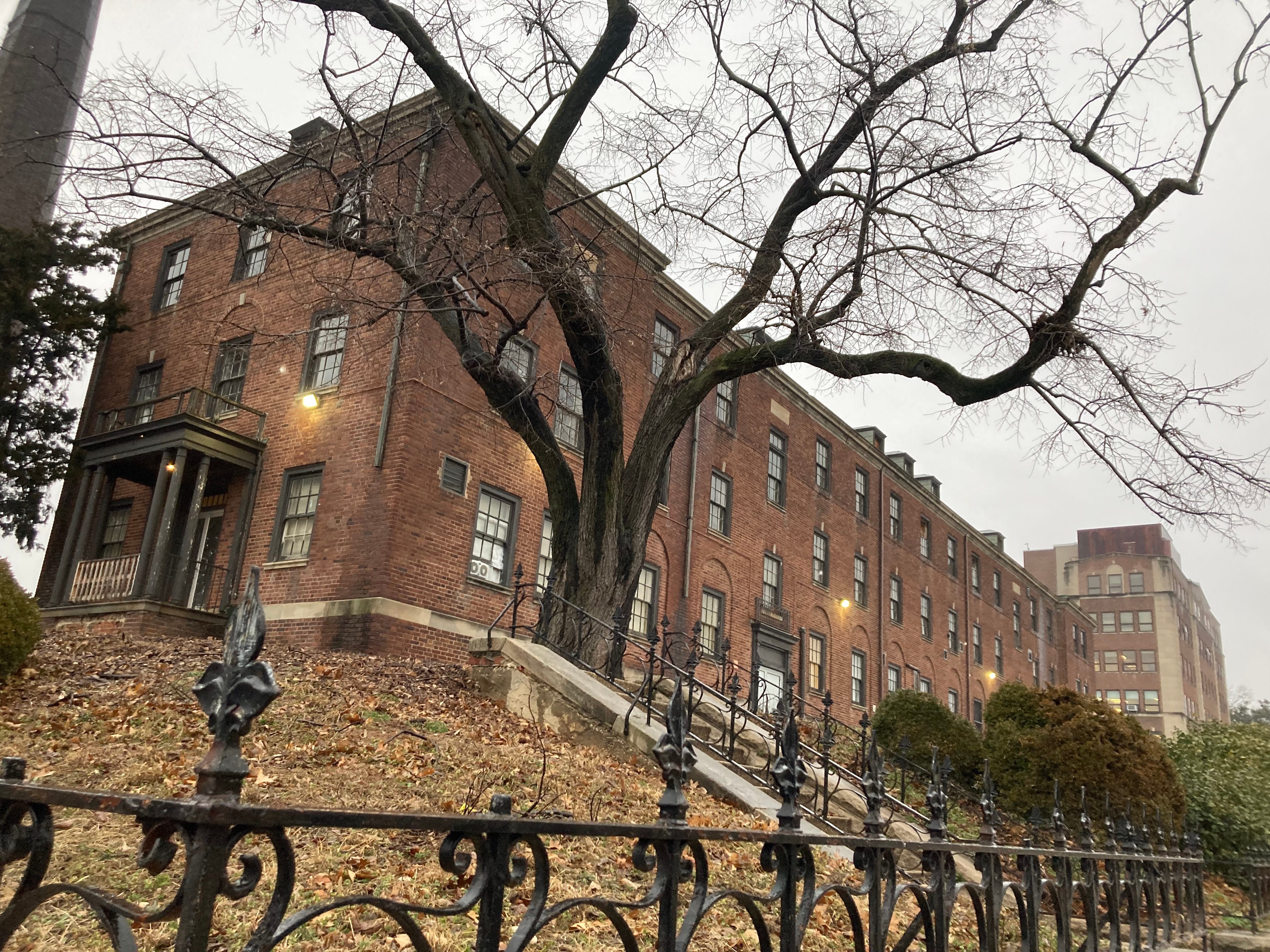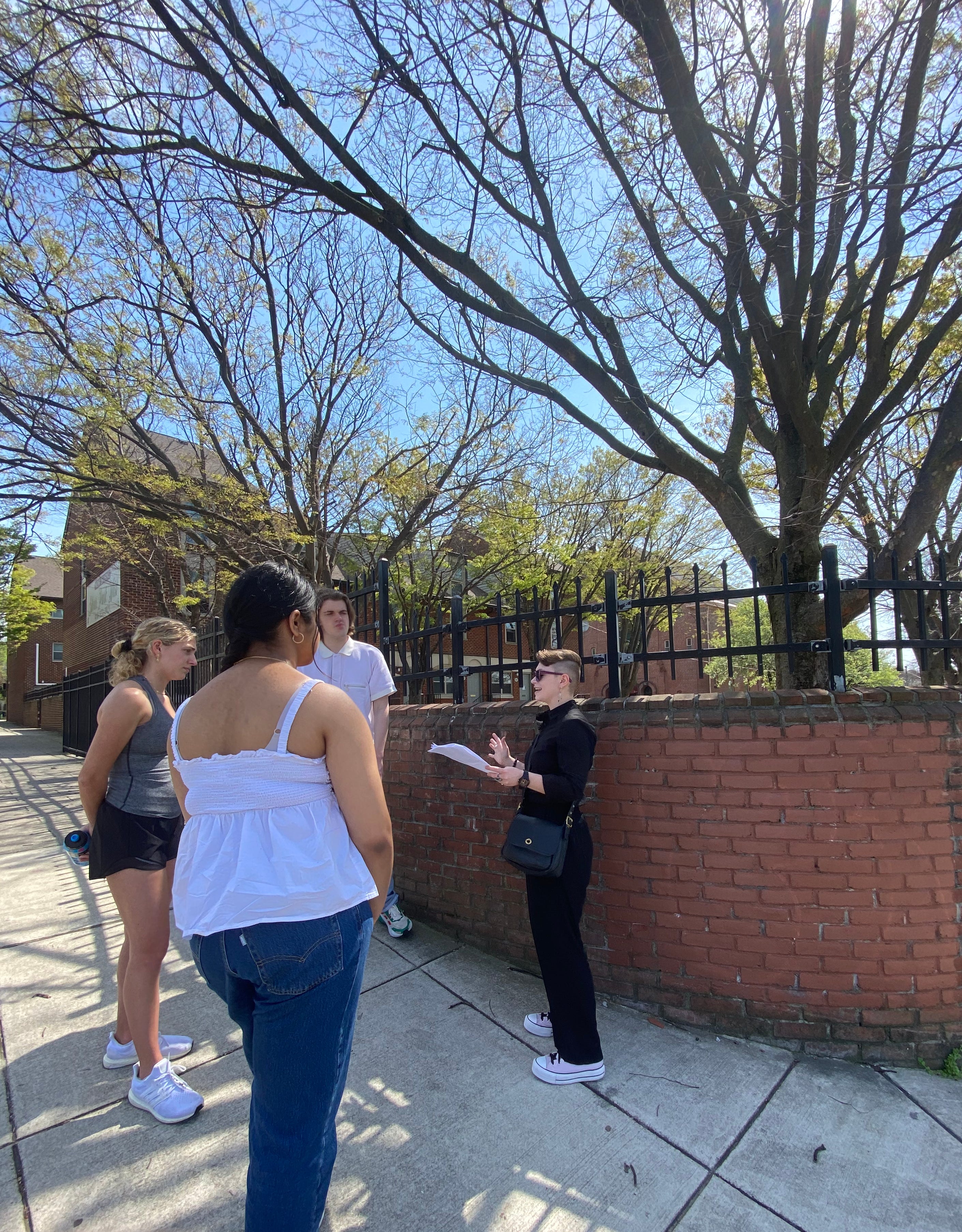“We endeavor to have good discipline, a spirit of obedience and industry, both in household work & in study.” – Lady Managers of the Johns Hopkins Hospital Colored Orphan Asylum, 1885 [1]
On a hot day in early April, members of the Hard Histories Spring 2023 Research Lab took a short drive to Baltimore’s Mount Vernon neighborhood to embark on a special walking tour, planned by Emma Katherine Bilski, our lab’s research and teaching assistant and a doctoral candidate in history. Through a present-day lens, the tour gave us an opportunity to orient ourselves the landscape that the children of the Johns Hopkins Hospital Colored Orphan Asylum (JHH COA) would have grown up in, before the asylum moved to its Remington location in 1895. The tour also allowed us to observe telling contrasts between the JHH COA’s two locations, Biddle Street and Remington.
Even before embarking on Emma Katherine’s tour, our lab developed a strong sense of the historical relevance of space and place. We learned, for example, that the Wyman Park Building on the Homewood Campus of Johns Hopkins University, where the lab met each week, was built directly on top of the site of the JHH COA’s second, Remington, location. Early in the semester, we set off on an exploratory walk that led us just a few steps from our classroom to the precise location where the Orphan Asylum once stood, where the girls in residence at the site were trained to be domestic servants.

Emma Katherine began our tour of the first Biddle Street home of the JHH COA at another notable place in our story: the site of the Johns Hopkins University campus, at the corner of Howard and W. Centre Streets. Unlike the Orphan Asylum, which housed primarily Black girls, the University educated almost exclusively young white men. Although a dog park now covers most traces of the original JHU campus, this initial stop made our quick walk to the Orphan Asylum’s Biddle Street site particularly striking. These two institutions, approximately five blocks apart, contained lives that likely remained separate except for the names of the institutions to which they belonged.
On the tour, Emma Katherine noted that, according to the 1880 US Census, the site of the Orphan Asylum, at the intersection of Biddle Street and Druid Hill Avenue, was situated in a diverse neighborhood. It was home to Black as well as white Baltimoreans, both native-born and immigrant residents. This starkly contrasted with the second JHH COA site where the girls were surrounded by the summer homes of wealthy white Baltimoreans. What a change. The move would have presented the girls with a true mismatch of neighborhoods even if they were kept relatively cloistered within the house.
At Remington, the girls occupied a space converted from a summer home owned by Maryland Governor William Pinkney Whyte. Its view eventually included construction of the Johns Hopkins University’s Homewood Campus. The girls experienced Mr. Hopkins’ charitable gift to them as the opportunity to become domestic servants, while also they witnessing the inequity of his philanthropy. In a short fifteen-minute car ride between sites, our group had traveled back in time from the asylum’s final Remington site to the first Biddle Street site, and introduced us to an earlier vision of the Orphan Asylum’s place in the city.

Emma Katherine’s cartographic expertise became evident as she navigated us to historically relevant locations in the first JHH COA neighborhood which today lacks any historical buildings at all. Most significantly, there is no sign of the site where the Johns Hopkins Hospital Colored Orphan Asylum once sat. Fortunately, however, the nearby building that once housed the Orchard Street Church congregation remains standing in the twenty-first century. Today it is home to the Greater Baltimore Urban League. From the JHH COA records in the Alan Mason Chesney Medical Archives, we gleaned that their weekly Sunday walk to this historically Black church was a rare regular outing for the girls residing in the Orphan Asylum. For me, the short walk between the first site of the Orphan Asylum and the Orchard Street Church made our time-traveling adventure real.
All of the surviving archival documents from the JHH COA were written by, to, and for the white Baltimoreans who managed the Orphan Asylum, making it exceedingly difficult to hear any resonances from the girls themselves while sitting in the Chesney Archive reading room. Thanks to Emma Katherine’s tour, even if the voices of the girls are too faint in the documentary sources, by walking the sites of their day-to-day lives and listening closely, their lived experiences is accessible to us today.
Emma Petite, KSAS BA ‘24
Emma Katherine Bilski, Editor
[1] JHH B/T Vol 1, Articles of Incorporation & June 13, 1870 to June 8 1906, Minutes of the Board of Trustees Johns Hopkins Hospital, Alan Mason Chesney Medical Archives, Baltimore, MD.


